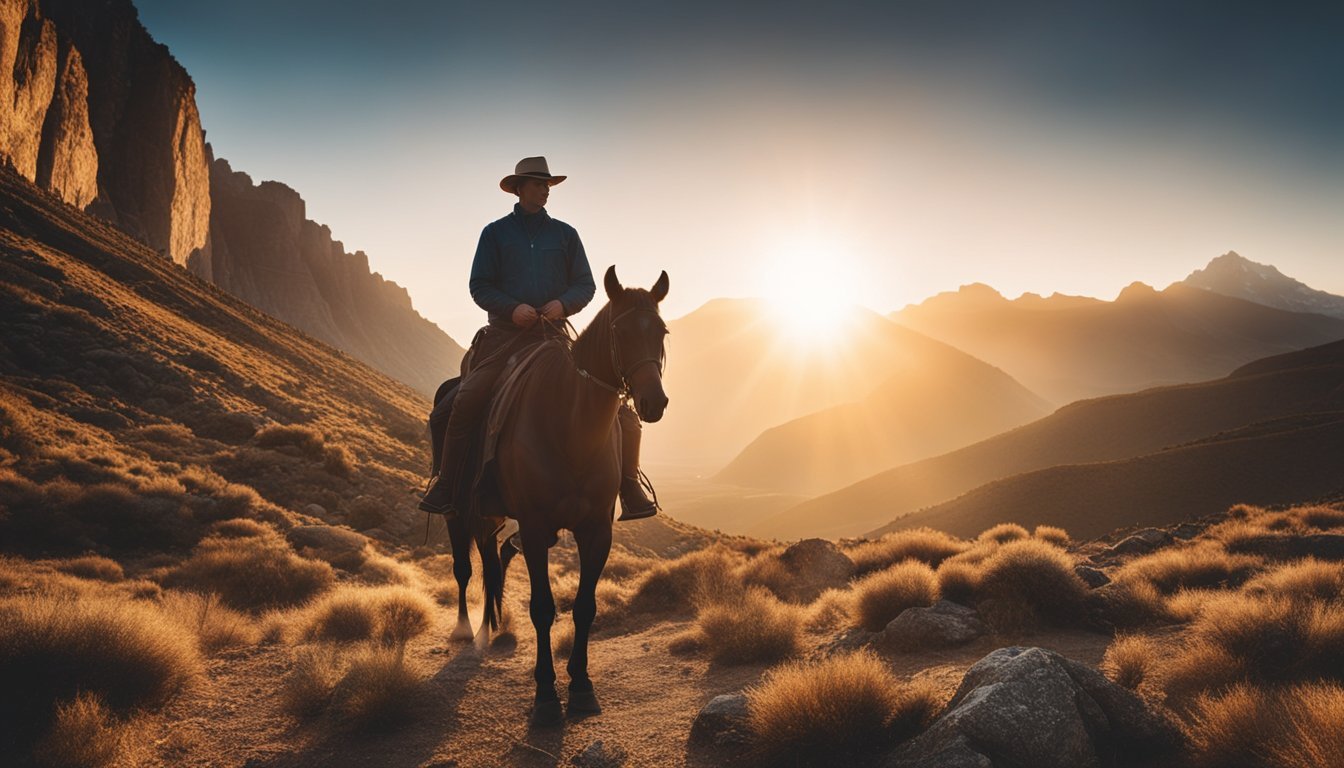6 Tiburcio Vasquez Documentaries
California's Most Notorious Bandit Explored on Screen
Tiburcio Vasquez was one of California's most notorious bandits in the mid-19th century. His daring exploits and criminal activities earned him both infamy and a place in the state's folklore. Vasquez's life and legacy have captivated historians and storytellers for generations, leading to numerous documentaries exploring his controversial persona.
These documentaries offer viewers a glimpse into the complex world of Vasquez and the turbulent times in which he lived. They shed light on the cultural tensions, social inequalities, and political upheavals that shaped his path from a young Californio to a wanted outlaw. By examining Vasquez's story, these films provide valuable insights into California's rich and often tumultuous history.
1) "Tiburcio Vasquez: The Life Behind the Legend" (2009)
This documentary explores the complex life of Tiburcio Vasquez, one of California's most infamous bandits. It delves into his early years, providing context for his later actions.
The film examines Vasquez's transformation from a young man in Mexican California to a notorious outlaw. It highlights key events that shaped his path, including his first brush with the law and subsequent prison escapes.
Interviews with historians and descendants offer insights into Vasquez's motivations and the social conditions of 19th-century California. The documentary also addresses the cultural divide between Anglo-Americans and Californios during this period.
"The Life Behind the Legend" presents a balanced view of Vasquez, acknowledging his crimes while exploring claims of injustice against Hispanic Californians. It concludes with an analysis of Vasquez's lasting impact on California's history and folklore.
2) "California's Bandit: Tiburcio Vasquez"
"California's Bandit: Tiburcio Vasquez" (2010) explores the life of one of California's most notorious outlaws. The documentary delves into Vasquez's background and the factors that led him to a life of crime.
Viewers learn about Vasquez's early years and his transformation into a feared bandit. The film examines his motivations and the social context of 19th-century California that shaped his actions.
The documentary covers Vasquez's most infamous exploits, including robberies and escapes from law enforcement. It also touches on his reputation as a folk hero among some segments of the Hispanic population.
Interviews with historians and descendants of those involved in Vasquez's story provide insight into his complex legacy. The film presents a balanced view of Vasquez, neither glorifying nor condemning his actions.
Archival footage and reenactments bring Vasquez's era to life, giving viewers a sense of the Old West. The documentary concludes with Vasquez's capture and execution, marking the end of an era in California's history.
More information on "California's Bandit: Tiburcio Vasquez" (IMDB)
3) "The Legacy of Tiburcio Vasquez"
Tiburcio Vasquez left an indelible mark on California's history. His exploits as an outlaw in the mid-19th century continue to captivate audiences today.
Vasquez's legacy is complex and controversial. Some view him as a folk hero who fought against Anglo-American oppression, while others see him as a ruthless criminal.
Several places in California bear Vasquez's name, including Vasquez Rocks Natural Area Park in Los Angeles County. This scenic location was one of his hideouts during his bandit days.
Vasquez's life has inspired numerous books, films, and documentaries. These works explore his motivations and the social context of his crimes.
Some historians argue that Vasquez's actions were a form of resistance against the discrimination faced by Californios after the Mexican-American War. This perspective has led to ongoing debates about his place in history.
Vasquez's story continues to resonate with discussions about cultural identity and social justice in California. His legacy serves as a reminder of the state's complex multicultural past.
4) "Notorious Outlaw: Tiburcio Vasquez"
Tiburcio Vasquez gained notoriety as one of California's most infamous bandits during the 19th century. Born in Monterey in 1835, he turned to a life of crime in his teenage years.
Vasquez led a gang that engaged in cattle rustling, horse theft, and armed robbery across California. His charisma and daring exploits made him a folk hero to some, especially among the Hispanic population.
In 1874, Vasquez and his gang conducted a brazen raid on the town of Tres Pinos, resulting in three deaths. This incident intensified the manhunt for the outlaw.
Authorities finally captured Vasquez in Los Angeles in May 1874. He was tried and convicted of murder, then executed by hanging in San Jose in 1875.
Vasquez's life and crimes have been the subject of numerous books, articles, and documentaries. His legacy as a controversial figure in California history continues to fascinate researchers and the public alike.
5) "Tales of Tiburcio Vasquez: California's Infamous Bandit" (2010)
This documentary explores the life and legacy of Tiburcio Vasquez, one of California's most notorious bandits. The film examines Vasquez's background and the circumstances that led him to a life of crime in the 19th century.
Through interviews with historians and descendants, the documentary paints a complex portrait of Vasquez. It delves into his Robin Hood-like reputation among some Mexican-Americans and his status as a folk hero.
The film also addresses the controversial aspects of Vasquez's life, including his alleged involvement in multiple murders and robberies. It presents a balanced view of his actions and their impact on California's history.
"Tales of Tiburcio Vasquez" uses historical reenactments and archival materials to bring the bandit's story to life. The documentary provides context for the social and political climate of California during Vasquez's time.
More information on "Tales of Tiburcio Vasquez: California's Infamous Bandit"
6) "The Man and the Myth: Tiburcio Vasquez" (2019)
This documentary explores the complex legacy of Tiburcio Vasquez, delving into his life as both a historical figure and a cultural icon. The film examines Vasquez's transformation from a young man in Mexican California to a notorious outlaw in the American West.
Interviews with historians and descendants of Vasquez provide insight into his motivations and the social context of his time. The documentary addresses the conflicting narratives surrounding Vasquez, including his reputation as a Robin Hood figure among some Mexican-Americans.
Archival footage and reenactments bring Vasquez's exploits to life, showcasing his daring escapes and charismatic personality. The film also explores how Vasquez's story has been interpreted and reimagined over time, influencing literature, art, and popular culture.
"The Man and the Myth" offers a balanced perspective on Vasquez's life, acknowledging both his criminal activities and his significance as a symbol of resistance against Anglo-American dominance in 19th-century California.
Learn more about Tiburcio Vasquez on Wikipedia
Early Life of Tiburcio Vasquez
Tiburcio Vasquez's early years were marked by his birth into a prominent Californio family and his descent into a life of crime as a youth. His background and early experiences shaped the notorious bandit he would become.
Birth and Family Background
Tiburcio Vasquez was born on April 11, 1835, in Monterey, Alta California, then part of Mexico. He came from a well-established Californio family with deep roots in the region. His great-grandfather arrived with the DeAnza expedition in 1776, making Vasquez a third-generation Californian.
Vasquez's parents were José Hermenegildo Vásquez and María Guadalupe Cantúa. Following Spanish tradition, he celebrated his birthday on August 11, the feast day of his namesake saint, St. Tiburtius.
Youth and Early Criminal Activities
As a young man, Vasquez became involved in criminal activities. He participated in numerous burglaries, cattle thefts, and highway robberies throughout California during the 1850s. This period marked the beginning of his two-decade-long career as an outlaw.
Vasquez's criminal pursuits led to multiple arrests and incarcerations. He served three separate terms in San Quentin State Prison, totaling about ten years. Despite these periods of confinement, Vasquez continued his life of crime upon release.
His early experiences as a bandit laid the groundwork for his later notoriety and the legends that would surround his name in California's history.
Criminal Career
Tiburcio Vasquez's criminal activities spanned over two decades, marked by daring robberies and a growing gang of outlaws. His notoriety spread throughout California as he evaded capture and led increasingly brazen heists.
Formation of the Gang
Vasquez began his life of crime in his teens after a dispute at a fandango in Monterey in 1854. He fled and joined a gang of cattle rustlers, quickly rising through the ranks. By the 1860s, Vasquez had formed his own gang, recruiting mostly young Californios who felt disenfranchised after the Mexican-American War.
The gang operated across Central and Southern California. Vasquez's charisma and leadership skills attracted loyal followers. He trained them in horsemanship, shooting, and evasion tactics. The group grew in size and sophistication, allowing them to take on more ambitious targets.
Major Heists and Robberies
Vasquez and his gang carried out numerous high-profile robberies. In 1873, they raided the town of Hornitos, robbing several businesses and citizens. Later that year, they struck Tres Pinos in San Benito County, resulting in three deaths during a store robbery.
One of their most daring heists occurred in 1874 at Repetto Ranch near Los Angeles. The gang held the family hostage and used the ranch as a base to rob wagon trains. This brazen act increased the bounty on Vasquez's head to $8,000.
Vasquez's criminal career came to an end in May 1874 when he was captured in present-day West Hollywood. His exploits had made him infamous, with rewards offered for his capture both dead or alive.
Capture and Execution
Tiburcio Vasquez's reign as California's most notorious bandit came to an end in 1874. His capture and subsequent trial captivated the public, leading to widespread media coverage and debate.
Arrest and Trial
In May 1874, authorities tracked Vasquez to a hideout in present-day West Hollywood. Sheriff William Rowland led a posse that surrounded and captured the bandit without bloodshed. Vasquez was taken to Los Angeles for trial, facing charges of murder from the Tres Piños incident.
The trial began in January 1875 and lasted one week. Prosecution witnesses identified Vasquez as the leader of the gang responsible for the murders. Despite his claims of innocence, the jury found Vasquez guilty after just two hours of deliberation.
Public Reaction and Legacy
Vasquez's capture and trial generated intense public interest. Newspapers provided extensive coverage, with some portraying him as a romantic folk hero while others condemned him as a vicious criminal.
After his conviction, Vasquez was sentenced to death. He was hanged on March 19, 1875, at San Jose. Thousands gathered to witness the execution. Vasquez's final words proclaimed his innocence.
In the years since, Vasquez has become a controversial figure in California history. Some view him as a Robin Hood-like character who stood up for Mexican-American rights, while others see him simply as a violent outlaw.



